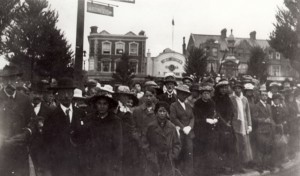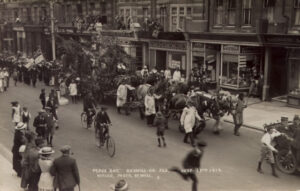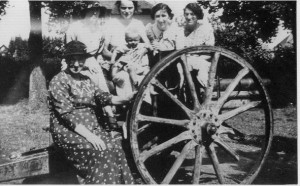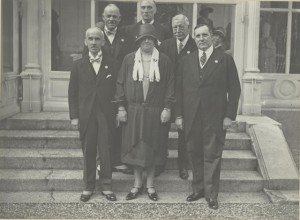The Armistice

The Armistice was signed at 5am on the 11th November 1918 and began at 11am, the eleventh hour of the eleventh day of the eleventh month. It was an agreement to end the fighting between France, Germany and Britain which would then lead on to peace negotiations. Six months later the peace treaty or “The Treaty of Versailles” was signed between these nations.
The signing of the Armistice agreement took place in a railway carriage in the Forest of Compiegne, north of Paris. The railway carriage belonged to Ferdinand Foch a French military commander who was one of the people who signed the agreement. Twenty two years later in 1940 Adolf Hitler used the same railway carriage when he forced France to surrender to Germany during the Second World War.
In the Armistice agreement Germany was ordered to give up her heavy guns, field guns, and machine guns as well as her aeroplanes and submarines. Germany was also requested to give up a number of warships and to disarm the ones she was allowed to keep. These requests were to ensure Germany could not restart the war and therefore break the agreement. If Germany had broken any of the Armistice terms, hostilities between the nations would have begun again within two days.
The Armistice agreement and the Treaty of Versailles also forced Germany to accept the blame for the First World War, including the loss of millions of lives. Germany was made to pay reparations for the damage caused, which was estimated to be approximately £22 billion. This war debt was finally paid off in 2010 with a final payment of £59 million.
In Britain in 1919 on the first anniversary of the Armistice, a memorial service was held in Whitehall in front of the temporary Cenotaph, and a two minutes silence was held at 11am to commemorate the time when the guns fell silent. In 1920 a permanent Cenotaph was unveiled and it became central to Britain’s annual commemorative ceremonies held on the 11th November, apart from during the Second World War when it was considered too dangerous to have mass groups of people congregating in central London, and around the country. Following the Second World War the day became known as Remembrance Day and commemorated both World Wars. Commemorative ceremonies were also moved to the closest Sunday.
In Bexhill the Armistice was marked by relief and celebration as much as commemoration. As the local newspaper put it
“The tragedy of the past four and a quarter years had come to an end – the world’s travail (suffering) was over.”
Peace Day, 19th July 1919

Bexhill’s Mayor Alderman G.H. Gray read the Peace Proclamation from the steps of the Town Hall on 2nd July 1919. A Peace Thanksgiving Service was held in the Egerton Park Pergola on Sunday 6th, and Peace Day was celebrated on Saturday 19th July 1919. The town was decorated with flags and bunting and toy ‘victory trumpets’ went on sale to children. One reporter remarked “the noise of Peace seemed to be worse than the noise of war!” but went on to note that
“We were in danger of forgetting our brave lads – at least some of us were who had received our loved ones back from the carnage unhurt.”
A procession of Bexhill men and women who had served in the war and decorated vehicles travelled through the town to Egerton Park, accompanied by the Band of the Artists’ Rifles O.T.C. In the park there were entertainments and sports for children and a picnic tea. Evening entertainment was a masquerade ball at the Colonnade with music by the Bor and Paikin’s Jazz Band. The day concluded with fireworks on the beach and bonfires at the West cliff and Galley Hill.
Demobilised Men’s Day, 10th September 1919
Bexhill’s soldiers were officially thanked on Demobilised Men’s Day on Wednesday 10th September 1919. In their civilian clothes they marched in procession through the decorated town centre to the seafront. A memorial service was held at the Colonnade, which concluded with the band playing the funeral march, and sounding the ‘Last Post’. To lift people’s spirits again the afternoon was devoted to sports in Egerton Park accompanied by music on the bandstand. Games included a pillow-fight, tug-of-war and a slow bicycle race. There were even special races for children who had lost their fathers in the war.
Aftermath of the First World War
Bexhill had sent over 2000 men to the various Fronts, as well as nurses, ambulance drivers, stretcher bearers and doctors. By the end of the War at least 250 men had been killed and a further 330 wounded. At least two nurses had also died. Following the War Office’s decision in 1915 not to repatriate the bodies of dead British servicemen, families at home were unable to bury their loved ones and were denied a grave to mourn. Some men whose bodies were found were buried in the vast war cemeteries constructed by the Imperial War Graves Commission (later Commonwealth War Graves Commission) near to the various battlefields. Sadly, there were also thousands of men whose bodies were never found and have no final resting place. Their names were added to the various monuments built within the cemeteries. At home, Britain saw a mass building of war memorials from the national Cenotaph to local memorials erected by towns, villages and churches.
Bexhill also seems to have largely avoided the horrors of the ‘Spanish flu’ influenza pandemic of 1918-20, perhaps due to Bexhill’s famous health giving environment. However some local families did lose children to it who were stationed elsewhere. Ex-Bexhill Mayor Daniel Mayer, lost his son Corporal Emile Mayer of the Royal Garrison Artillery to influenza and pneumonia at the Milton Military Hospital in 1918.
Although the war ended in November 1918, many people continued to suffer all the wartime hardships, including low pay. Throughout 1919 they rebelled in a massive wave of strikes. A sense of emergency returned to Bexhill in autumn 1919, when the National Union of Railwaymen, whose wages had been cut, went on strike. In Bexhill plans were made to use all forms of vehicles belonging to local people to distribute food supplies around the region. After a week the government gave in and the worker’s wages were reinstated, demonstrating how dependent the country was on its railway infrastructure.
Women, War Work and the Vote
The war had also significantly challenged the distinctions between male and female occupations, and profoundly affected the Votes for Women campaign. Bexhill’s suffragettes had suspended their campaign on the outbreak of war, as women had foreseen an opportunity to demonstrate that they could work as hard as men. During the war, women had proven to be just as vital to the war effort as the men at the Front, even though they received only approximately half the wages of their male equivalents, and often faced a great deal of prejudice and resentment. When the men returned home following the Armistice the women were expected to give up their new found freedom and return to their pre-war roles. Some were happy to do this, while others struggled to readjust. Women’s experiences during the war would fuel the future changes to the lives of women and the women’s rights campaign. The Representation of the People Act of 1918 gave property owning women over the age of thirty the vote. Ten years later in 1928 women were finally given equal voting rights to men for the first time.
 War Savings Fundraising Appeals
War Savings Fundraising Appeals
People from Bexhill made a substantial financial contribution both during and after the war, and thousands of pounds were raised through a continuous round of ‘War Savings’ fund raising appeals. ‘Business Week’ had raised £60,000, ‘Gun Week’ £47,000 and ‘Victory Loan Week’ £114,000. In 1919 the National War Savings Committee rewarded Bexhill with its own tank Muriel, named after Countess De La Warr, which for many years was parked on West Parade. The War Office Trophies Committee also presented the town with another war memento, a German field gun and carriage which became a popular landmark of Sidley Green.
 Bayencourt
Bayencourt
From Christmas 1920 there was a desire in Bexhill to assist the war torn village of Bayencourt, in the Somme area of northern France. The 5th Battalion Royal Sussex Regiment, which included local men, had been based there in 1916 and had got to know the village well. It was decided a fund would be established to help restore the village’s water supply. The project was championed by Councillor E.W. Bowrey who as mayor led a civic delegation to Bayencourt in 1924. This led to further fundraising and another civic visit in 1930. To commemorate the town’s link with its adopted village two new streets in Sidley were named Bayencourt North and Bayencourt South in 1924.

